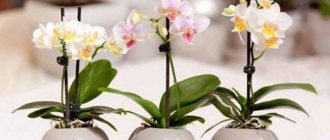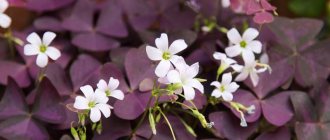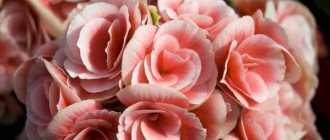Have you decided to transform your interior? Please note that today designers are concerned not only with how to renovate and furnish a room. No less important is the ability to decorate it with furniture and decorative elements so that it becomes elegant and stylish, filled with an atmosphere of comfort and individuality. Among various decorative finds, modern designers like to use special indoor plants - succulents. With their help, you can transform your interior yourself, without turning to a designer. Having learned about the propagation of succulents and the rules for caring for them, you will understand that these undemanding and original plants must be in your home.
What's so attractive about succulents?
Succulent garden
The name succulents, translated from Latin as “succulent”, was given to these plants due to their ability to store moisture for future use in their trunks and leaves. Therefore, they do not require special care and do not require frequent watering.
The variety of succulents is impressive. Tiny that can be grown in test tubes, and impressive in size, they look good in a home conservatory or just on a windowsill. Succulents stand out for their bizarre shape, surprising with the unexpected color of their leaves and unusual flowering.
It is believed that an indoor succulent shares useful energy with a person. It is no coincidence that they are recommended to be placed near a computer monitor; they have a beneficial effect on humans, some types have a healing effect.
Many people remember aloe; this is one of the varieties of succulents that our grandmothers considered mandatory to have on the windowsill. It is recommended to have a fat tree or “money tree” in your apartment or office to ensure financial well-being.
Some of the most popular succulents are also “living stone” and sedum, agave and various types of crassula, milkweed, echeveria and many other flowers.
Read more about Indoor succulents - varieties, care features
Let's find out in more detail how exotic indoor succulents are bred using leaves, plant cuttings or its seeds.
What to do if the plant does not take root?
Containers for planting must have holes ; if they are not there, then the growth of leaves with poor air permeability becomes problematic.
In the absence of sufficient lighting, additional sources should be used.
Organic fertilizers should not be used as fertilizer for young plants.
Echeveria, as a perennial succulent, has no difficulties growing at home . The main factors for successful leaf propagation are the correct choice of lighting and air humidity, as well as timely care and watering. By following the recommendations, you will get a beautiful exotic succulent at home that does not require much attention.
Using a propagation sheet
To start the type of plant you like, a leaf is enough. Propagation by leaves is a fairly simple and affordable method.
It is necessary to carefully consider the choice of leaf intended for propagation. It should be a strong, healthy leaf, without damage. You should not tear off or break off the leaf; to propagate it, you need to cut it off with a sharp knife, without leaving parts of it on the plant.
The cut leaf should not be placed in water; on the contrary, it must be kept in the air for a day or two so that the leaf dries out somewhat. The leaf needs to be dried on the surface of the soil in which it will grow. You don’t need to do anything special for rooting, you just need to turn the cut of the leaf towards the soil. Everything else will happen without our actions, the leaf will take root on its own!
Video “Propagation of succulents by leaves”
Representatives of the genus Sedum
Sedums are a genus of succulents from the Crassula family. These plants forgive all the mistakes that a novice gardener might make. When overwatering plants, you can quickly cut a new cutting and plant it.
Sedums or Sedum are affordable succulents for beginners.
Sedums are distinguished by fleshy leaves of different shapes, it depends on the variety. There are no petioles, the leaf blades are in the form of short needles, cylinders or elongated balls. The leaves can be colored in different colors - soft green, bluish, cream, reddish or purple. Some Sedums may have two-color leaves - green at the base and pinkish and purple at the tips. There are amazing species that change their shade depending on the location - in the shade or in the sun. Caring for the plant is quite simple and comes down to proper watering and fertilization.
Cuttings of succulents
Another equally popular and simple method of propagating these exotic plants is cuttings.
The cuttings are also cut with a sharp knife and left to dry for a couple of days. You should definitely pay attention to the plant that gave the cutting. The resulting cut should be sprinkled with coal, which was previously crushed. In this case, before processing, you need to inspect the cut. If the plant is a species that secretes milky sap, the cut is first washed and then treated with charcoal.
Propagation by cuttings is a longer process. You can plant a cutting in the ground only after it has roots.
About rooting cuttings - more details
To root a succulent cutting, you can place it in a year or in a sand mixture. This method is the most suitable for cuttings of different types of euphorbia and crassula.
Rooting in water
Place the cutting in a container with clean, settled water (you can take boiled or distilled water), making sure that its lower part with the cut does not touch the bottom. At room temperature, the cuttings take root within 2-3 weeks. To create more favorable conditions, you can create greenhouse conditions for the plant. To do this, simply cover it with a clean and transparent plastic bag.
Subtleties of rooting in water:
- Treating the cutting with a growth stimulant before immersing it in liquid will make the process more effective.
- The container with the cuttings should be kept in a well-lit place at room temperature, adding water as necessary.
- If the cut rots, the cutting should be cut off and placed again in a container with clean water, after drying and treating with a growth stimulator.
Rooting in the sand
Sand mixture is usually used for rooting sansevieria. A cutting treated with a strengthening compound (Epin, Kornevin) is placed in prepared sand (sifted and fried in the oven or in a frying pan), then watered with warm water.
There is no need to deepen the cutting too much. 1.5 - 2.5 cm in depth is optimal for the plant.
During the process of rooting in sand, the cuttings are also kept in a warm and bright place.
Video “Propagation of succulents by cuttings”
Greenhouses and lighting
After planting, you need to spray the cuttings with water and Zircon and put them in a greenhouse. The greenhouse is a container covered with plastic film, into which cuttings are included with a margin of height. The greenhouse can be made from an old glass aquarium, maybe not completely airtight, a deep plastic basin or container. A mini-greenhouse can be built from a 5-liter or 1.5-liter water bottle, cutting it crosswise.
The cuttings must be kept in conditions of high humidity until they form their own roots, which will take over the process of supplying the plant with water. But in addition to 100% humidity, cuttings need light to root. It is not recommended to place cuttings in the sun, since overheating inside the greenhouse is possible, so additional lighting is provided. Special phytolamps, especially LED ones, are best suited for illumination, but it is quite sufficient to use cheaper, albeit less economical, fluorescent lamps. By the way, among them there are energy-saving phytolamps, which, however, produce pink light that is not very pleasant to the eyes.
Daylight hours should optimally last 12 hours. Observance of day and night is mandatory. The optimal temperature for rooting is +25 degrees; at lower temperatures, root formation is reluctant. For many plants (for example, bougainvillea), bottom heating is desirable when the substrate temperature is higher than the air temperature. On my shelving, this is achieved by heating from a fluorescent lamp, which illuminates the shelf below.
I expect the first results of rooting in 2 weeks for myrtle, melaleuca, callistemon, rosemary, abutilon, fig, ficus. After a month - for hibiscus, bougainvillea, metrosideros, eugenias, psidiums, citrus fruits, olives. I carefully take out the cups - the formed roots are clearly visible through the transparent walls of the cups.
Propagation by seeds
Succulents can be grown from seeds. To do this, you will need soil consisting of fried sand and earth. In containers, the prepared mixture is covered with a thin sand layer (no more than 2 mm in thickness). The seeds are first dipped in a weak solution of potassium permanganate and left for 24 hours. The seeds treated in this way are placed in a thin layer of sand, which is spilled with the same solution before laying out. The container is covered with polyethylene, creating a “mini-greenhouse”. It is kept in a warm and bright place until sprouts appear. The germination period for different species ranges from 2 to 14 days. Diving can be done no earlier than a month after the sprouts appear. But the final transplant is possible only later; at least 6 months must pass before that.
Planting succulents
To ensure the successful development of the plant, you need to follow simple planting rules.
Choosing a pot
Planting fancy flowers starts with deciding which succulent pot will work best. When choosing a container for planting, it is necessary to determine how the flower is supposed to be grown, whether it will be a single planting or a composition of flowers will be created in a pot. In this regard, a more or less spacious pot is selected. Planting in a flat flower container is also popular. You should not choose a pot that is too large. In this case, the growth of the plant will be slowed down: the succulents first “master” the planting pot with their roots and only then use the energy to develop the upper, above-ground part of the plant.
When choosing a container for planting, the gardener independently gives preference to the material from which it is made (plastic or clay), as well as the shape of the pot. A mandatory requirement for any planting container is the presence of a drainage hole in the bottom of the pot.
Video “Choosing a pot for succulents”
Soil preparation
The next step is to prepare succulent-friendly soil. Flower and garden stores sell soil for indoor succulents. In addition to this soil, it is necessary to prepare river sand and expanded clay for drainage.
Fill the pot in the following sequence: first layer - drainage, 2nd layer - wet soil mixture, 3-1 layer - sand.
Landing
The succulent is planted in soil mixture. The sprout is carefully placed in the pot without damaging the roots of the flower. The soil mixture should cover the roots up to the root collar, which should be in the sand layer. This will keep the plant from rotting.
Adaptation
An important moment in the life of a plant is the adaptation period and care after reproduction. For 1-1.5 weeks, the plant is protected from direct sunlight to avoid burns and is not watered. The moisture content of the soil mixture will be sufficient, but its excess can lead to rotting.
Video “Soil for succulents”
Possible problems
For both leaf and cutting propagation, it is important to monitor some points that can lead to problems and even death of the succulent. Wrinkles on planting material are considered normal, but if the fragments change their color to brown or soften, then it is not recommended to use them further. The humidity level must be controlled. At the stage of root emergence and germination, excess liquid can lead to mold and further rotting. This situation can be prevented by using good drainage and initially purchasing a pot with a sufficient number of holes.
Caring for Succulents
Succulents are an undemanding houseplant. But you can’t do without following the basic rules of care.
- Watering
These indoor flowers do not need abundant watering. The frequency of watering depends on the time of year. In winter, plants are watered less often; succulents at room temperature are watered no more often, 1-2 times a month. Starting in spring, watering becomes more frequent: every 7-10 days.
- Fertilizer
Succulents respond well to weak solutions of phosphorus-potassium fertilizers without nitrogen or with a minimal amount of it. Frequent application of fertilizers - 1-2 times a month.
The industry also offers special complex fertilizers for succulents. When using them, specific instructions for use must be followed.
By following these simple rules for propagating, planting and caring for flowers, you can do more than just start succulents at home. An original composition of beautiful and unusual plants will become a real interior decoration.
Tips for laying concrete garden paths with your own hands
The technology for laying concrete paths differs depending on the type of tiles used. For example, when using the above-mentioned "Garden Path" shape, due to the uneven side edges, curbs are not required. When installing rectangular tiles or paving stones, they are required. Their presence will give the sidewalk a complete look.
Filling moldsSource www.geeksmartbuy.com
When doing the work yourself, consider the following nuances:
- In the process of preparing the sandy base, carefully level the surface; this can be done using a building level. Later, this will significantly save time that will be spent on laying the finishing coating.
- When making concrete, add a plasticizer. It will increase the strength and setting time of the composition. The dye will give the product the desired shade.
- A layer of geotextile spread under the sand cushion will become a barrier to weed shoots breaking through the seams between the tiles.
- When pouring molds on site, after finishing work, cover the surface with plastic wrap. Otherwise, due to uneven and rapid drying, the tiles of the path will crack. In hot weather, it is recommended to moisten with water at least once a day.
- You can lubricate the tile mold with used car oil - cheap and cheerful.
- The seams between the tiles are filled with sand or grout (a dry mixture of sand and cement in a ratio of 1/4). This is done like this: the composition is poured onto the garden path, swept with a broom, and spilled with water. By repeated, similar actions, all voids are completely closed.
Concreting procedureSource mhremont.ru/
Beautiful paths to the houseSource remoo.ru/
The classic concrete pouring method has been and is in trend among designers and builders. This is one of the simplest options for arranging a garden path with your own hands. You can give a small alley an original, unusual style through alternate experiments of combining concrete with various materials.
You can create a kind of sidewalk if you add natural sea pebbles to the cement-sand mixture; broken (but not sharp) glass shimmering in the sunlight. You can fit the resulting composition into the overall design of the site by using flirty fresh flowers instead of the usual borders.
Decorative paths in a flower bedSource beton-house.com
A simple path in the yardSource zgnrus.ru/











